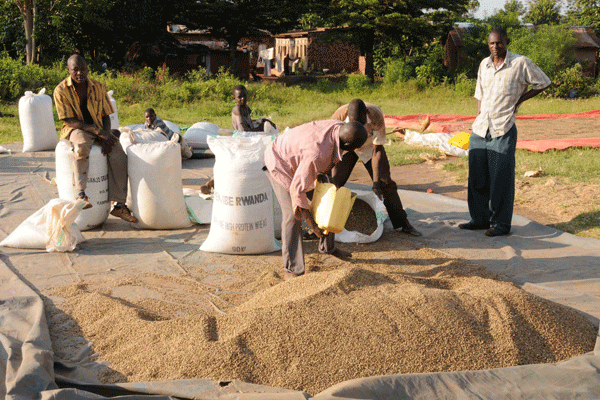Prime
Govt improves irrigation schemes to reduce dependence on rain-fed farming

Rose Namayanja
What you need to know:
- Support interventions. Due to the growing need to support farmers, there has been improved supply of agricultural inputs (seeds, seedlings and stocking materials) to boost production and productivity, support interventions aimed at developing agribusiness enterprises, promoting value addition and market linkages for agricultural produce.
The agriculture sector was hit by prolonged dry spells in 2016/2017 that continued into early to 2017/2018. These drought periods contributed to decline in production, and rise in prices of both foodstuffs and dairy products. Accordingly, the dependence of the sector on rain continued to pose a threat to Uganda’s macroeconomic performance.
Over dependence on rain-fed agriculture has for long been a major challenge to agriculture production and productivity in the country. The World Bank observes that the increasing unreliability and unpredictability of rainfall necessitates expanded irrigation as well as improved water management to increase resilience to higher and more extreme climate variability.
The erratic changes in the rain patterns have accelerated the rate at which water volumes are reducing thus affecting both crop and livestock production.
During 2017/2018, 65 potential sites for irrigation were identified of the planned 15 for small-scale irrigation as a result of government increased investment in water for agricultural production, in addition to recruitment of water engineers at the district level. The engineers have constructed small-scale irrigation demonstration projects in different local governments.
This was manifested in the commissioning of the construction of five irrigation schemes of Doho II in Butaleja District (1,178 ha); Mubuku II in Kasese District (480 ha); Wadelai in Nebbi District (1,000 ha), Tochi in Oyam District (500 ha) and Ngenge (880ha) in Kween District.
The Ministry of Agriculture, in partnership with the Ministry of Water and Environment commissioned the construction of the five irrigation schemes.
The sector constructed detailed demonstrations for 30 small-scale irrigation out of the planned 15. A total of four new crop-based irrigation schemes designs were completed in Tochi Irrigation- Oyam, Ngenge -Kween, Doho II-Butaleja and Mubuku II- Kasese districts.
MAAIF rehabilitated 51 of the planned 40 existing valley dams through the local governments in districts specifically in the cattle corridor using the heavy earth moving equipment acquired in the FY 2017/2018 in districts of Kayunga, Nakasongola, Kiruhura, Kiboga, Mubende, Kamuli, Wakiso, Gomba and Isingiro.
The 2017 National Irrigation Policy highlights the total irrigated area to be expanded to 400,000ha by 2040 from 15,000ha of cultivated land, which is under irrigation countrywide, out of a potential area of 3.03 million hectares.
The role and obligation of National Agricultural Advisory Services (Naads) has been evolving from Naads to Operation Wealth Creation (OWC).
The Naads new mandate is to provide support for the management of agricultural input distribution chains, promotion of strategic commodity interventions, agricultural chain development, and farmer access to agricultural financing. OWC aids distribution of agricultural inputs, and facilitation of agricultural production chains across the country as one of the strategies to eradicate poverty and ease the growth of household income through agriculture.
Due to the growing need to support farmers, there has been improved supply of agricultural inputs (seeds, seedlings and stocking materials) to boost production and productivity, support interventions aimed at developing agribusiness enterprises, promoting value addition and market linkages for agricultural produce.
Naads delivered its mandate throughout 2017/2018. Under increased production and productivity of priority and strategic commodities 877,124 units of priority and strategic commodities were established, of the planned 685,200. This was as a result of re-allocation of additional resources from value addition to support the Atiak Sugarcane Project in Amuru District.
Strategic commodities for household income and export market to include tea, fruits (mangoes, citrus, pineapples and apples) and cocoa, and food security interventions through constituency food security campaigns by Members of Parliament, especially for maize seed, was an added advantage to delivering on the output. At least nine of the planned seven field verification and inspection exercises were carried out in a bid to manage agricultural input distribution. The verification was specifically in the case of tea and cocoa that required urgent attention.
Through support to upper-end agricultural value chain and agribusiness development, 100 per cent performance of the targeted commodity platforms (four of four) were supported in Agribusiness Development Services commodity at local government level.
These activities were boosted by the supervisory initiatives by the NAADS Board of Directors and Technical staff to monitor farmers in the zones. A number of guidelines (two of three) for farmers continued to be formulated and disseminated. These facilitated agricultural inputs for crop and livestock distribution.
The Parliamentary Committee on Agriculture in its Report on the Countrywide Assessment of OWC Programme recommended that government puts in place a legal framework for implementing OWC Programme for “it is currently operating under Standing Orders of Procedure.”
In line with the observation, the OWC under Naads, went under implementation review of its interventions to ascertain the overall efficiency, effectiveness, impact, relevance and sustainability in the context of its objectives, to make it more significant for the country.
Ms Namayanja is the national treasurer, National Resistance Movement




